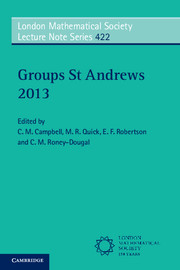Book contents
- Frontmatter
- Contents
- INTRODUCTION
- Approximate subgroups and super-strong approximation
- Width questions for finite simple groups
- Profinite properties of discrete groups
- GL(n, Z), Out(Fn) and everything in between: automorphism groups of RAAGs
- Permutation groups and transformation semigroups: results and problems
- New progress on factorized groups and subgroup permutability
- A survey on the normalizer problem for integral group rings
- A survey on Clifford-Fischer theory
- A generalisation on the solvability of finite groups with three class sizes for normal subgroups
- Automorphism groups of non-orientable Riemann surfaces
- What are the C2-groups?
- Resurrecting Wells’ exact sequence and Buckley's group action
- Recent work on Beauville surfaces, structures and groups
- Something for nothing: some consequences of the solution of the Tarski problems
- The groups of projectivities in finite planes
- On the relation gap and relation lifting problem
- Some results on products of finite subsets in groups
- Formal languages and group theory
- On the Castelnuovo-Mumford regularity of the cohomology of fusion systems and of the Hochschild cohomology of block algebras
- Recent advances on torsion subgroups of integral group rings
- On finite groups with small prime spectrum
- Solvability criteria for finite loops and groups
- The rational subset membership problem for groups: a survey
- A survey of Milnor laws
- Capable p-groups
- On the normal structure of a finite group with restrictions on the maximal subgroups
- Certain monomial characters and their normal constituents
- Recognition of finite quasi-simple groups by the degrees of their irreducible representations
- Generalized Baumslag-Solitar groups: a survey of recent progress
- Zeta functions of groups and rings – recent developments
A survey on Clifford-Fischer theory
Published online by Cambridge University Press: 05 September 2015
- Frontmatter
- Contents
- INTRODUCTION
- Approximate subgroups and super-strong approximation
- Width questions for finite simple groups
- Profinite properties of discrete groups
- GL(n, Z), Out(Fn) and everything in between: automorphism groups of RAAGs
- Permutation groups and transformation semigroups: results and problems
- New progress on factorized groups and subgroup permutability
- A survey on the normalizer problem for integral group rings
- A survey on Clifford-Fischer theory
- A generalisation on the solvability of finite groups with three class sizes for normal subgroups
- Automorphism groups of non-orientable Riemann surfaces
- What are the C2-groups?
- Resurrecting Wells’ exact sequence and Buckley's group action
- Recent work on Beauville surfaces, structures and groups
- Something for nothing: some consequences of the solution of the Tarski problems
- The groups of projectivities in finite planes
- On the relation gap and relation lifting problem
- Some results on products of finite subsets in groups
- Formal languages and group theory
- On the Castelnuovo-Mumford regularity of the cohomology of fusion systems and of the Hochschild cohomology of block algebras
- Recent advances on torsion subgroups of integral group rings
- On finite groups with small prime spectrum
- Solvability criteria for finite loops and groups
- The rational subset membership problem for groups: a survey
- A survey of Milnor laws
- Capable p-groups
- On the normal structure of a finite group with restrictions on the maximal subgroups
- Certain monomial characters and their normal constituents
- Recognition of finite quasi-simple groups by the degrees of their irreducible representations
- Generalized Baumslag-Solitar groups: a survey of recent progress
- Zeta functions of groups and rings – recent developments
Summary
Abstract
Bernd Fischer presented a powerful and interesting technique, known as Clifford- Fischer theory, for calculating the character tables of group extensions. This technique derives its fundamentals from the Clifford theory. The present article surveys the developments of Clifford-Fischer theory applied to group extensions (split and non-split) and in particular we focus on the contributions of the second author and his research groups including students.
Introduction
The character table of a finite group is a very powerful tool to study the group structure and to prove many results. Any finite group is either simple or has a non-trivial normal subgroup and hence will be of extension type (non-trivial). The classification of finite simple groups, more recent work in group theory, has been completed in 1985 and since then the researchers concentrated on the generation, subgroup structures of the finite simple groups and their automorphism groups. Few also studied the interplay between finite simple groups and combinatorial structures. A knowledge of the character table of a finite group G provides considerable information about G and hence it is of importance in the Physical Sciences as well as in Pure Mathematics. Character tables of finite groups can be constructed using various theoretical and computational techniques. The character tables of all the maximal subgroups of the sporadic simple groups are known, except for some maximal subgroups of the Monster M and the Baby Monster B. There are several well-developed methods for calculating the character tables of group extensions and in particular when the kernel of the extension is an elementary abelian group. For example, the Schreier-Sims algorithm, the Todd-Coxeter coset enumeration method, the Burnside-Dixon algorithm and various other techniques. Bernd Fischer [18, 19, 20] presented a powerful and interesting technique for calculating the character tables of group extensions. This technique, which is known as Clifford-Fischer matrices, derives its fundamentals from the Clifford theory [17].
- Type
- Chapter
- Information
- Groups St Andrews 2013 , pp. 160 - 172Publisher: Cambridge University PressPrint publication year: 2015
- 3
- Cited by



